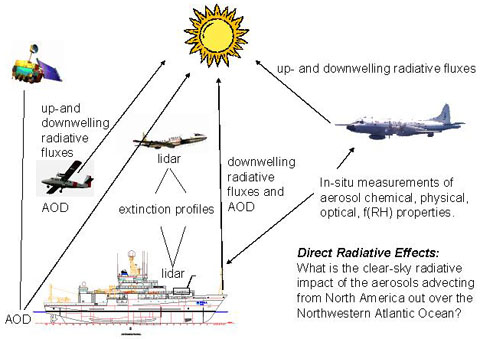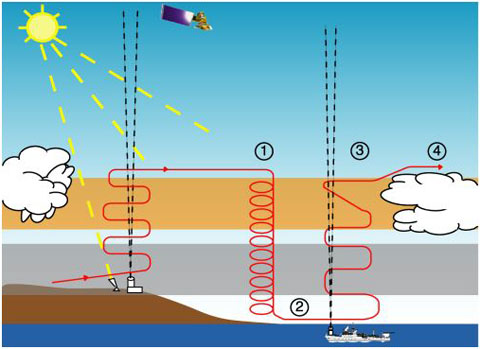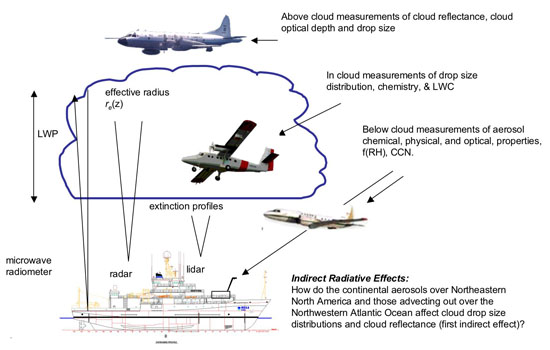Research
Radiation Balance
Rational: Atmospheric aerosol particles affect the Earth's radiative balance directly by scattering (Charlson et al., 1992) and absorbing (Ramanathan and Vogelmann, 1997) sunlight and indirectly by acting as cloud condensation nuclei (CCN), thereby influencing the albedo(first indirect effect, Twomey, 1991), life-time (Albrecht, 1989), precipitation (Rosenfeld, 2000) and extent (Ramanathan et al., 2001) of clouds. Aerosol concentrations and their radiative impacts are particularly high in regions downwind of sources where diurnally-averaged clear sky surface forcings range up to 30 Wm-2 (Russell et al., 1999; Ramanathan et al., 2001). International field campaigns during the past 7 years have studied aerosol properties and their direct radiative effects downwind of North America (1996 - TARFOX), Europe (1997 - ACE-2), SE Asia (1999 - INDOEX), and Asia (2001 - ACE-Asia). During these 7 years of major field programs our scientific tools for measuring aerosols and their radiative properties and our understanding of the complex chemistry and transport processes have evolved tremendously. We propose to use these new tools to quantify the aerosol properties, controlling processes and radiative effects over Northeastern North America and off the U.S. East Coast during ICARTT 2004. Measurements during NEAQS 2002 showed that the U.S. pollution plume can be as intense (in terms of aerosol mass concentration, aerosol optical depth, and ozone mixing ratio) as those downwind of India and Asia (Quinn and Bates, 2003). NEAQS 2002, however, did not specifically measure the direct or indirect radiative effects of this aerosol pollution plume.
Participants and Platforms: ICARTT 2004 will include coordinated multi-agency international field experiments to investigate the direct and indirect radiative effect of aerosols over Northeastern North America and the downwind North Atlantic Ocean. The ICARTT partners in this effort include NOAA/OAR, CalTech/ONR, the Meteorological Service of Canada, and NASA-GTE. Together these partners will field 5 heavily instrumented aircraft, a research ship, and several ground stations. The in-situ and sub-orbital remote sensing measurements will be guided in the field with a hierarchy of model products and satellite observations. Although each agency will have their own science plan and objectives, all have agreed to coordinate efforts to address many of the experiments outlined under the overall scientific questions listed below.
Direct-effect Experimental Plan: What is the clear-sky radiative impact of the aerosols advecting from North America out over the Northwestern Atlantic Ocean?
The following represent a set of planned experiments to (1) quantify aerosol properties and the direct aerosol radiative forcing and (2) intercompare and/or verify critical measurements:
- Measure/calculate aerosol properties and clear sky radiative forcing under a variety of conditions (e.g. downwind of different point and regional sources; at various altitudes and distances from shore; at different times of day; under different meteorological conditions).
- Compare directly measured aerosol scattering, backscattering, and absorption coefficients with those calculated from the measured size distributions and chemical composition (local closure).
- Compare directly measured f(RH) with values calculated from aerosol size distributions and chemical composition.
- Compare measured aerosol properties with those determined from chemical transport models.
- Compare aerosol extinction at the surface measured by several techniques.
- Comparison of aerosol optical depth spectra measured by sunphotometers (surface and airborne) and retrieved from satellite radiances.
- Compare radiative fluxes determined from shipboard, aircraft, and satellite sensors (clear sky column closure).
- Compare clear sky forcings derived from models using measured aerosol properties and flux radiometers.
- Compare single scattering albedo measured at the surface and aloft with that derived from airborne sunphotometer and solar spectral flux measurements.
- Integrate the results of these measurements/comparisons to assess the regional clear-sky direct radiative forcing.

Deployment Strategy (regional characterization and direct radiative forcing): Use a combination of chemical forecast models and surface and airborne lidars to determine the location and vertical distribution of aerosol plumes. Position the ship and aircraft to make in situ measurements of aerosol size distributions, chemical composition, f(RH), and scattering and absorbing properties within the plumes at the surface (ship and ground station) and aloft (aircraft). Measure surface (ship), vertically resolved (aircraft) and top of atmosphere (satellite) aerosol optical depth. In addition, measure downwelling radiative fluxes at the surface (ship) and up- and downwelling radiative fluxes of aerosol layers aloft (aircraft). Coordinate measurements with satellite overpasses. Combining these measurements will allow for a complete characterization of the aerosol at the surface and throughout the lower troposphere and a determination of clear sky forcing through a variety of techniques.

Illustration of the flight patterns used to reveal aerosol radiative effects and relate them to aerosol properties determined from space, air, land and sea. (1) Survey Vertical Profile. (2) Minimum-Altitude Transect. (3) Parking Garage. (4) Above-Cloud Transect.
Indirect-effect Experimental Plan: How do the continental aerosols over Northeastern North America and those advecting out over the Northwestern Atlantic Ocean affect cloud drop size distributions and cloud reflectance (first indirect effect)?
The following represent a set of planned experiments to compare and/or verify critical measurements that control the aerosol indirect effect.
- Compare measured CCN spectra with those calculated by thermodynamic models of aerosol activation, given measured aerosol size distribution and chemical composition (CCN closure).
- Compare cloud drop concentrations measured near cloud base with those predicted by models of cloud activation given observed updraft velocity and CCN spectrum (CCN-cloud droplet number closure). Assess the importance of chemical composition on CCN-cloud droplet number closure.
- Compare measured above-cloud reflectance (airborne and satellite) with that calculated using in-cloud and below-cloud measurements of aerosol chemistry and microphysics.
- Compare surface retrievals of cloud drop size profiles and liquid water content with in-situ airborne measurements and satellite retrievals.
- Assess the ability of parcel models and large eddy scale models to represent observed cloud microphysical processes, cloud dynamical and microphysical evolution, cloud lifetime and precipitation efficiency.
There is a need to establish whether aerosol-CCN closure experiments can be achieved under a range of aerosol conditions, including those containing high organic aerosol fractions. Recent attempts at this closure (VanReken et al. 2003) during the CRYSTAL-FACE experiment were significantly more successful than prior attempts (e.g. Chuang et al. 2000) likely due to improvements in CCN instrumentation and the simple chemical composition of the aerosol (dominated by ammonium sulfate). A large source of uncertainty in previous studies may be due to organic species (Charlson et al., 2001). Many aerosol-CCN comparisons implement Köhler theory and assume a mixture of a pure soluble salt, such as ammonium sulfate or sodium chloride, and insoluble material, neglecting detailed treatment of organic materials. Theoretical and laboratory studies indicate that organics may alter the activation characteristics of aerosol by reducing the mass accommodation coefficient of water (Bigg et al., 1986; Saxena et al., 1995; Feingold and Chuang, 2002) or by decreasing droplet surface tension (Facchini et al., 1999). Partially soluble aerosols (Shulman et al., 1996) and soluble gases (Laaksonen et al. 1998) may also contribute to uncertainties in the predictions of Köhler theory when the concentrations or properties of such species are unknown.
Aerosol-drop concentration closure is similar in concept to aerosol-CCN closure except that predictions of cloud drop concentration based on measured CCN (or aerosol size and composition) and cloud updraft velocity are compared to those measured directly by cloud probes. This closure is reasonably well achieved when aerosol composition is homogeneous but is more difficult to achieve for heterogeneous composition, or in the presence of certain organic species. An important part of this effort is the measurement of the cloud updraft velocity which drives the production of supersaturation. Hence, measurement of a supersaturation spectrum is of more importance in this closure effort than in the aerosol-CCN closure. The measurement of CCN (or aerosol size/composition), updraft velocity, and drop size distribution also provides strong constraints for numerical parcel models that simulate droplet activation.
Although the above-described closure experiments are crucial to our understanding of aerosol effects on clouds, the aerosol indirect effect must ultimately be quantified as a radiative response in terms of cloud reflectance to space. Using multiple aircraft and shipboard measurements we will compare cloud reflectance with that calculated based on surface remote sensing, in-situ microphysical measurements, and radiative transfer modeling. ICARTT 2004 will perform cloudy column experiments (e.g., Brenguier et al. 2000) in horizontally homogeneous cloudy conditions over the Gulf of Maine and/or south of Lake Erie in Ohio, Pennsylvania, New York States and SW Ontario, Canada. The latter region is downwind of large urban areas with prevailing winds from the north and west following frontal passages. Stratocumulus clouds are common during the day- and nighttimes. On some days, convective cumulus and cumulonimbus are present, thus providing a variety of cloud types for the various goals outlined here.
The cost of aircraft missions and the difficulty of continuous long term monitoring of cloud microphysics has spurred development of ground-based retrievals of cloud microphysics using active and passive remote sensors. Cloud radars and microwave radiometers have been used to measure cloud drop size profiles in non-precipitating, warm clouds (Frisch et al. 2002). Average cloud drop sizes are also derived from measurements of cloud optical depth and liquid water path (LWP) (Min and Harrison, 1996). During ICARTT 2004 we will deploy a cloud radar and microwave radiometer on board the Ronald H. Brown to routinely profile cloud drop sizes. Lidar profiling of subcloud aerosol will also be performed. This combination of instruments provides the basis for surface remote retrieval of the first aerosol indirect effect (Feingold et al. 2003).
The measurements to be acquired during NEAQS-2004 represent an opportunity to test various models of aerosol-cloud interaction. Observations of aerosol, cloud microphysical and dynamical parameters will enable us to test the ability of cloud parcel models to represent cloud droplet formation. Models will ingest aerosol size distribution/composition and vertical velocity measurements from aircraft and we will compare measured and model-derived drop concentrations. Under well-mixed conditions, similar comparisons will be performed from the ship using surface aerosol size and composition measurements together with Doppler lidar, or radar to measure updraft velocity. Here comparisons of cloud drop sizes will be made. Comparisons will be made both for individual clouds and in a statistical sense by using probability density functions (pdfs) of input parameters and comparing pdfs of model output with pdfs of observed parameters.
A large eddy simulation model that integrates coupled dynamics, aerosol and cloud microphysics, aqueous chemistry and radiation, will be applied as an interpretive tool to a number of case studies (Feingold and Kreidenweis 2002). Observations will provide constraints on cloud evolution (macroscale and microphysical properties), precipitation formation, and sulfate production. Model simulations will be used to test hypotheses pertaining to aerosol indirect effects, including dynamical feedbacks. Convective redistribution of aerosol and gases will also be explored using our soluble-aerosol tracking tools. These activities will be coordinated with the MSC's Convair operations that specifically address measurements of this process.
Deployment Strategy (indirect radiative forcing): Measurements will be conducted in two areas: (1) south of Lake Erie and Southern Ontario and (2) Gulf of Maine. The two sites will include surface based measurements (ground station or ship) of in-situ aerosol properties and remotely sensed cloud properties (e.g., liquid water path, cloud droplet effective radius). Aircraft will be coordinated below, within and above cloud to simultaneously measure in-situ aerosol properties used to calculate CCN (physical size distribution, chemical size distribution, f(RH)), CCN, cloud droplet number concentration, size distributions and chemistry, updraft velocities, liquid water content, and cloud radiative properties.

2004 Implementation Plans:
- Aircraft & Ship Coordination
- Surface Networks
- Measurement Comparison
and Appendix
